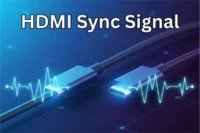HDMI Key Terms: A to Z
Published: 14 Aug 2025
HDMI (High-Definition Multimedia Interface) is the most widely used connection for transmitting high-quality audio and video between devices like TVs, computers, gaming consoles, and home theater systems.
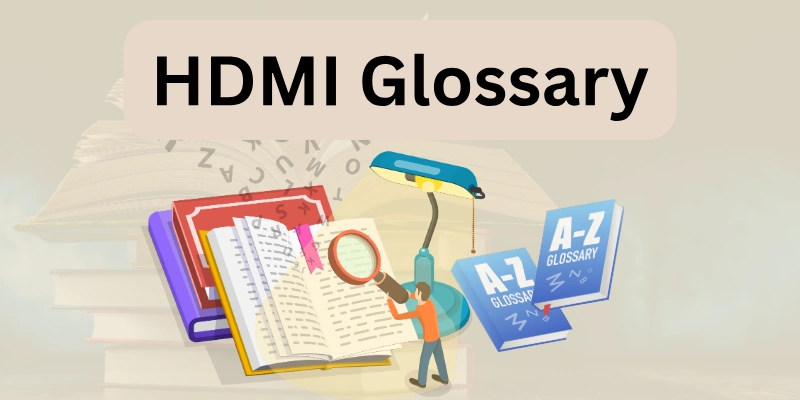
And, no doubt, HDMI technology comes with a lot of technical terms and jargon, which can sometimes be confusing. To make things easier, here is the A to Z list of HDMI glossary terms, covering everything from basic concepts to advanced features.
Whether you’re a beginner, gamer, home theater enthusiast, or AV professional, this glossary will help you understand HDMI in simple words.
Let’s dive in!
A-Z HDMI Glossary: Every Term Explained
Here it begins—your ultimate HDMI glossary:
Terms with A
This list covers all possible HDMI terms starting with “A” in a very simple way.
- Active HDMI Cable – A special HDMI cable with built-in electronics to boost signal strength over long distances.
- Adapter – A small device that helps connect HDMI to other types of ports like VGA, DVI, or DisplayPort.
- Alternate Mode (HDMI Alt Mode) – A feature that lets USB-C ports send HDMI signals without needing an adapter.
- Ambient Light Rejection (ALR) – A technology in projector screens that makes images clearer in bright rooms.
- Analog Video – An old type of video signal that HDMI replaced because HDMI is fully digital.
- Anamorphic Widescreen – A method that stretches video to fit a widescreen display without losing quality.
- Anti-Aliasing – A feature that smooths out jagged edges in pictures or video games for a cleaner look.
- ARC (Audio Return Channel) – A feature in HDMI that sends sound from a TV back to a sound system without extra cables.
- Aspect Ratio – The shape of a screen, such as 16:9 (widescreen) or 4:3 (square-like).
- Audio Bitrate – The amount of audio data sent per second; higher bitrate means better sound quality.
- Auto Lip Sync – A feature that fixes delays between sound and video, so speech matches mouth movements.
- Auto Low Latency Mode (ALLM) – A setting that turns on gaming mode automatically to reduce lag while playing games.
Terms with B
This is a complete list of HDMI terms starting with “B”.
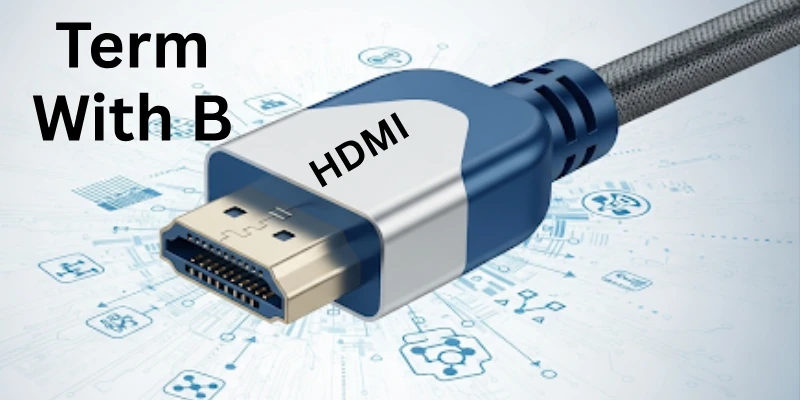
- Bandwidth – The amount of data HDMI can send per second (higher bandwidth = better video and audio quality).
- Bit Depth – The number of colors a display can show (common values: 8-bit, 10-bit, 12-bit).
- Black Level – Controls how deep the black colors look on a screen, affecting contrast.
- Blu-ray – A type of disc that plays high-quality movies in Full HD (1080p) or 4K using HDMI.
- Buffering – Temporary storage of video or audio to prevent stuttering or delays.
- Burn-in – A screen issue where a permanent ghost image appears, mostly on OLED and Plasma TVs.
- Bitrate – The speed at which HDMI transfers audio and video data, measured in Mbps (megabits per second).
- Backward Compatibility – HDMI’s ability to work with older HDMI versions but at lower quality settings.
- Brightness – The level of light a screen can produce, affecting how clear the image looks.
- Broadcast Signal – A TV signal sent over the air, cable, or satellite that can be displayed through HDMI devices.
Terms with C
This is a detailed list of HDMI terms starting with “C”.
- Cable Categories (HDMI) – HDMI cables are classified based on speed and performance, such as Standard HDMI, High-Speed HDMI, Premium High-Speed HDMI, and Ultra High-Speed HDMI.
- CEC (Consumer Electronics Control) – A feature that lets one remote control multiple HDMI-connected devices.
- Chroma Subsampling – A method of reducing color data to save bandwidth while keeping image quality high.
- Color Depth – The number of colors a display can show, measured in 8-bit, 10-bit, 12-bit, or 16-bit.
- Compression – A process that reduces the size of HDMI video and audio files without losing too much quality.
- Connector Types (HDMI) – HDMI ports come in different sizes: Standard HDMI (Type A), Mini HDMI (Type C), and Micro HDMI (Type D).
- Copy Protection (HDCP) – A security feature that prevents illegal copying of HDMI content.
- CRT (Cathode Ray Tube) Displays – Old-style TVs that use an analog signal, which HDMI has replaced with digital.
- Color Space – Defines how colors are represented in HDMI, such as RGB, YCbCr 4:4:4, 4:2:2, and 4:2:0.
- Chromatic Aberration – A slight color distortion in HDMI video, usually caused by poor cables or display issues.
- Closed Captioning – Text displayed on a screen for dialogue and sound effects, supported by HDMI devices.
- Cable Length Limits – HDMI cables work best at shorter lengths; long cables may need active HDMI for boosting signals.
- Compatibility Mode – A setting that helps older HDMI devices work with newer TVs or monitors.
- Contrast Ratio – The difference between the brightest white and the darkest black on an HDMI display.
- Consumer Video Format – Video formats commonly used in HDMI, such as 1080p, 4K, and 8K.
Terms with D
This is a detailed list of HDMI terms starting with “D”.
- Deep Color – An HDMI feature that increases color depth for smoother and more realistic images.
- DisplayPort to HDMI Adapter – A converter that allows a DisplayPort output to connect to an HDMI display.
- Dolby Atmos – A 3D surround sound technology that creates an immersive audio experience, supported via HDMI eARC.
- Dolby Vision – An advanced HDR (High Dynamic Range) format that improves brightness, contrast, and colors in HDMI video.
- Downscaling – The process of converting a high-resolution HDMI signal (e.g., 4K to 1080p) to match a lower-resolution screen.
- Dual-Link DVI to HDMI – An adapter that converts high-speed DVI signals to HDMI for better display compatibility.
- Display Refresh Rate – The number of times a screen updates per second (measured in Hz), supported through HDMI.
- DTS-HD Master Audio – A high-quality surround sound format supported by HDMI for home theater audio.
- Daisy-Chaining – A method of connecting multiple HDMI devices in a chain-like manner using one main connection.
- Digital Signal – HDMI transmits digital audio and video, replacing older analog signals like VGA or composite video.
- Dolby TrueHD – A lossless audio format used in HDMI connections for cinema-quality sound.
- DVI (Digital Visual Interface) – A video interface that can be adapted to HDMI but does not support audio natively.
- Dynamic HDR – An HDMI feature that adjusts HDR settings frame by frame for better picture quality.
- Dynamic Range – The difference between the lightest and darkest parts of an HDMI video image.
- Display Scaling – The ability to resize HDMI video to fit different screen resolutions.
- Driver (HDMI Driver) – Software that helps a computer recognize and use HDMI-connected displays or sound devices.
- Dropout – A brief loss of HDMI signal, often caused by poor cables, loose connections, or interference.
- DVR (Digital Video Recorder) – A device that records TV programs and can connect to HDMI for high-definition playback.
Terms with E
This is a detailed list of HDMI terms starting with “E”.
- eARC (Enhanced Audio Return Channel) – An improved version of ARC that supports high-quality audio formats like Dolby Atmos and DTS:X over HDMI.
- EDID (Extended Display Identification Data) – A system where HDMI automatically detects the best resolution and settings for a display.
- Electromagnetic Interference (EMI) – Signal interference caused by electrical devices, which can affect HDMI quality.
- Encoding – The process of converting video and audio into a digital format for HDMI transmission.
- Ethernet over HDMI – A feature in some HDMI cables that allows internet data sharing between connected devices.
- Equalization (HDMI Equalizer) – A technology that improves HDMI signal strength over long cables to avoid quality loss.
- EDTV (Enhanced Definition Television) – A display format that supports 480p resolution, which is better than SDTV but lower than HDTV.
- External HDMI Splitter – A device that duplicates an HDMI signal to multiple screens or displays.
- Embedded Audio – The feature that allows HDMI to carry both video and audio in a single cable.
- End-to-End Encryption – A security feature in HDMI that prevents unauthorized access to protected content (HDCP encryption).
Terms with F
This is a detailed list of HDMI terms starting with “F”.
- Frame Rate – The number of frames (images) displayed per second in a video, like 30fps, 60fps, or 120fps.
- Full HD (FHD) – A screen resolution of 1920×1080 pixels, also called 1080p.
- Flicker – A visual issue where the screen blinks or flashes, often caused by unstable HDMI signals.
- Firmware Update – Software updates for HDMI devices (like TVs and AV receivers) that fix bugs and improve performance.
- Fiber Optic HDMI Cable – A special HDMI cable that uses light signals instead of copper, allowing longer distances with no quality loss.
- Flat HDMI Cable – A type of HDMI cable with a flat design, making it easier to hide behind walls or carpets.
- Frame Buffer – A temporary memory storage where HDMI stores video frames before displaying them.
- Frame Dropping – When some frames are skipped due to low bandwidth or poor HDMI connection.
- FEC (Forward Error Correction) – A system in HDMI that helps fix errors in data transmission, improving stability.
- Fixed Rate Link (FRL) – A new technology in HDMI 2.1 that allows higher resolutions like 8K and 10K with better stability.
- Flashing Screen – A problem where the HDMI display turns on and off rapidly, often due to a loose connection or incompatible settings.
- Front Projection HDMI Setup – A setup where HDMI is used to connect projectors instead of TVs.
- Field of View (FoV) – The amount of the image that can be seen on an HDMI display, important for gaming and VR.
Terms with G
This is a detailed list of HDMI terms starting with “G”.
- G-Sync – A technology by NVIDIA that matches the screen’s refresh rate with the game’s frame rate to prevent screen tearing.
- Gamma Correction – Adjusts brightness and contrast in HDMI video to make images look more natural.
- Ghosting – A display issue where previous frames leave a faint trail on the screen, often caused by slow response time.
- Gamut (Color Gamut) – The range of colors a screen can display; wider gamuts like DCI-P3 provide richer colors.
- GPU (Graphics Processing Unit) – A computer chip responsible for rendering graphics, which sends video signals to an HDMI display.
- Gradient Banding – When smooth color transitions appear as visible bands, usually due to low bit depth in HDMI video.
- Ground Loop Interference – A buzzing sound caused by electrical interference in HDMI-connected devices.
- Gigabits per Second (Gbps) – The speed at which HDMI transfers data; for example, HDMI 2.1 supports 48 Gbps.
- Glass-to-Glass Latency – The total delay from when an HDMI source sends a signal to when it appears on the screen.
- Genlock (Generator Locking) – A feature that synchronizes HDMI video signals in multi-display setups to avoid flickering or misalignment.
- Gaming Mode – A setting on HDMI TVs that reduces input lag to improve gaming performance.
- Green Screen Issue – When an HDMI signal error causes the entire screen to turn green, often due to an HDCP handshake failure.
- Gradient Smoothing – A feature that reduces visible color banding by blending colors more smoothly.
- Graphical User Interface (GUI) – The on-screen menu of HDMI devices like TVs and AV receivers.
Terms with H
This is a detailed list of HDMI terms starting with “H”.
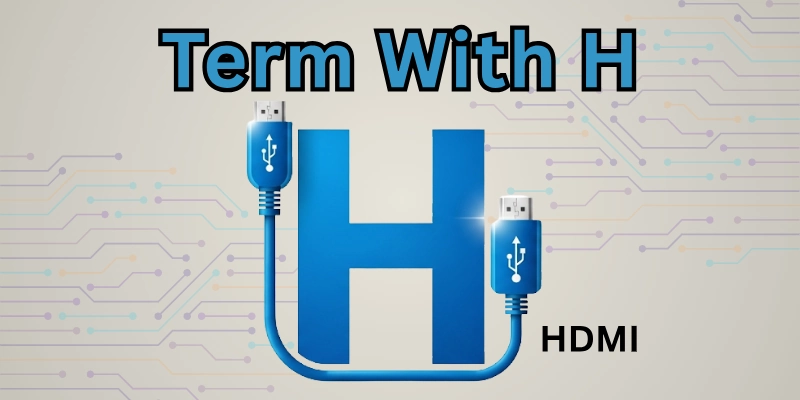
- HDCP (High-bandwidth Digital Content Protection) – A security feature that prevents unauthorized copying of digital content over HDMI.
- HDR (High Dynamic Range) – A technology that improves brightness, contrast, and color accuracy for a more lifelike image.
- HDMI (High-Definition Multimedia Interface) – A widely used audio and video connection for TVs, computers, gaming consoles, and more.
- HDMI 1.0 – HDMI 2.1 – Different versions of HDMI, with each newer version supporting higher resolutions, refresh rates, and features.
- HDMI Alt Mode (Alternate Mode) – A feature that lets USB-C ports output HDMI signals without needing an adapter.
- HDMI ARC (Audio Return Channel) – Allows a TV to send audio back to a soundbar or AV receiver using the same HDMI cable.
- HDMI eARC (Enhanced Audio Return Channel) – An improved version of ARC, supporting high-quality surround sound like Dolby Atmos.
- HDMI CEC (Consumer Electronics Control) – Allows one remote to control multiple HDMI-connected devices.
- HDMI Switch – A device that lets you connect multiple HDMI sources (like a PlayStation, Xbox, or Blu-ray player) to one TV.
- HDMI Splitter – A device that splits one HDMI signal into multiple displays.
- HDMI Repeater – A device that boosts HDMI signals to maintain quality over long cable runs.
- HDMI Extender – Increases the range of HDMI signals using Ethernet cables, fiber optics, or wireless transmission.
- Hot Plug Detection (HPD) – A feature that detects when an HDMI device is plugged in or removed and adjusts the signal automatically.
- HD Ready – A term for TVs that can display 720p resolution but may accept higher resolutions.
- High-Speed HDMI Cable – A faster HDMI cable that supports 1080p, 4K, 3D, and deep color.
- HFR (High Frame Rate) – HDMI feature that supports frame rates above 60 fps for smoother video and gaming.
- Hybrid Log-Gamma (HLG) – An HDR format designed for live broadcasts and streaming services.
- H.264 (AVC – Advanced Video Coding) – A common video compression format used in HDMI transmissions.
- H.265 (HEVC – High Efficiency Video Coding) – A newer, more efficient compression standard that reduces file size while keeping high quality.
- Hue – A setting that adjusts the color tones on an HDMI display.
Terms with I
This is a detailed list of HDMI terms starting with “I”.
- Interlaced Scanning – A video display method that shows odd and even lines alternately, often used in older TVs (e.g., 1080i).
- Image Scaling – The process of increasing or decreasing the resolution of an image to fit the screen.
- IMAX Enhanced – A certification for HDMI devices that support IMAX-quality video and audio.
- Input Lag – The delay between pressing a button (like on a game controller) and seeing the result on screen.
- Integrated Circuit (IC) – A tiny electronic chip inside HDMI devices that processes signals.
- Interoperability – The ability of HDMI devices from different brands to work together.
- IP Conversion (Interlaced to Progressive) – Converts interlaced video (e.g., 1080i) to progressive scan (e.g., 1080p) for smoother playback.
- Infrared (IR) Blaster – A feature that transmits remote control signals to HDMI devices, often used in home theater setups.
- Inrush Current Protection – A safety feature in HDMI ports that prevents power surges when plugging in a device.
- ISF Certification (Imaging Science Foundation) – A standard that ensures accurate color calibration in HDMI displays.
Terms with J
J has fewer HDMI-related terms, but these are the key ones!
- Jitter – Small distortions or timing errors in an HDMI signal that can cause screen flickering or audio issues.
- JPEG (Joint Photographic Experts Group) – A common image format that can be transmitted over HDMI in photo slideshows or media players.
- Jumbo Frames – A networking term sometimes relevant in HDMI over Ethernet, referring to larger data packets for faster transmission.
- Jitter Buffer – A technology that reduces jitter by temporarily storing HDMI audio/video data before playing it back.
- Jack (HDMI Jack/Port) – The physical connector where an HDMI cable plugs into a device.
Terms with K
That’s all for K!
- KVM Switch (Keyboard, Video, Mouse Switch) – A device that allows multiple computers to share one HDMI monitor and control system.
- KEF (Kent Engineering & Foundry) – A high-end audio brand that manufactures HDMI-compatible speakers.
- Kuro (Pioneer Kuro) – A famous plasma TV series that used HDMI for high-quality video output.
- Kilobits per Second (Kbps) – A unit of measurement for data transfer speed in HDMI audio transmission.
- Kilohertz (kHz) – A measurement of audio sample rate in HDMI audio formats (e.g., 48kHz, 96kHz, 192kHz).
- Keying (Chroma Keying) – A technique used in video production over HDMI to replace a background (like green screen effects).
- K-Scaler – A video scaling device that adjusts HDMI resolutions for better compatibility.
- Knoll HDMI Extender – A device that extends HDMI signals over long distances using Cat5e/Cat6 cables.
- Kelvin (K) – A unit used in color temperature settings for HDMI displays to adjust white balance.
- Key Exchange (HDCP Key Exchange) – A process in HDCP encryption where HDMI devices authenticate each other to prevent illegal copying.
Terms with L
That’s the full L list!
- Latency – The time it takes for an HDMI signal to travel from the source (like a console) to the display. Lower latency is better for gaming.
- LPCM (Linear Pulse Code Modulation) – An uncompressed digital audio format supported by HDMI for high-quality sound.
- LFE (Low-Frequency Effects) – A special audio channel in HDMI that sends deep bass sounds to subwoofers.
- Link Training – A process where HDMI devices communicate to establish a stable connection for video and audio signals.
- Local Dimming – A display technology used in HDMI-compatible TVs to improve contrast by dimming certain screen areas.
- Luminance – The brightness level of an image displayed via HDMI. Higher luminance means a brighter picture.
- Lossless Audio – High-quality audio formats (like Dolby TrueHD and DTS-HD) that HDMI can transmit without losing quality.
- Lossy Compression – A technique that reduces HDMI audio/video file sizes but may slightly lower quality.
- Long HDMI Cable – HDMI cables that extend beyond standard lengths (often using signal boosters or fiber optics).
- Lip Sync (Auto Lip Sync) – An HDMI feature that automatically corrects audio delays to match video playback.
- Low Latency Mode – A feature that reduces input lag in HDMI gaming and video streaming.
- Light Sensor (for HDMI displays) – A sensor in some HDMI-compatible TVs that adjusts brightness based on room lighting.
- LVDS (Low Voltage Differential Signaling) – A technology used inside HDMI displays to process signals with low power.
- Loopout (HDMI Loopout) – A feature that lets HDMI signals pass through a device to another screen without loss.
- Local Contrast Enhancement – A TV feature that improves HDMI image contrast in specific screen areas.
Terms with M
That’s the M HDMI list!
- Macroblocking – A video issue where large blocky artifacts appear due to HDMI signal compression.
- Metadata – Extra information in an HDMI signal that helps optimize video and audio quality (e.g., HDR settings).
- Micro HDMI – A smaller HDMI connector used in cameras, tablets, and small devices.
- MHL (Mobile High-Definition Link) – A technology that allows smartphones and tablets to connect to HDMI TVs via a special adapter.
- Mode Switching – When HDMI devices automatically switch between different resolutions, refresh rates, or HDR modes.
- Modulated Signal – A processed HDMI signal that can travel over long distances without losing quality.
- Motion Blur Reduction – A feature in HDMI-connected displays that smooths fast-moving images.
- Multi-Channel Audio – HDMI’s ability to transmit multiple audio channels (e.g., 5.1 or 7.1 surround sound).
- Multi-View HDMI (Picture-in-Picture Mode) – A feature that lets a screen display multiple HDMI sources at once.
- Matrix Switch (HDMI Matrix) – A device that lets multiple HDMI sources connect to multiple displays and switch between them.
- Maximum Bitrate – The highest amount of data an HDMI version can transfer per second (e.g., 48 Gbps for HDMI 2.1).
- Minimized Jitter – A feature in premium HDMI cables that reduces unwanted signal distortion.
- Mixed Audio Mode – A mode where HDMI devices combine multiple audio signals into one output.
- Mastered in 4K – A term for Blu-ray movies optimized for HDMI 4K playback.
- Multi-Format Audio – HDMI’s ability to support different audio formats like Dolby Atmos, DTS:X, and PCM.
- Metal Shielding – A feature in high-quality HDMI cables that prevents interference from other electronics.
- Monitor Mode – A setting where an HDMI screen acts as a basic display without extra processing.
Terms with N
That’s the N list!
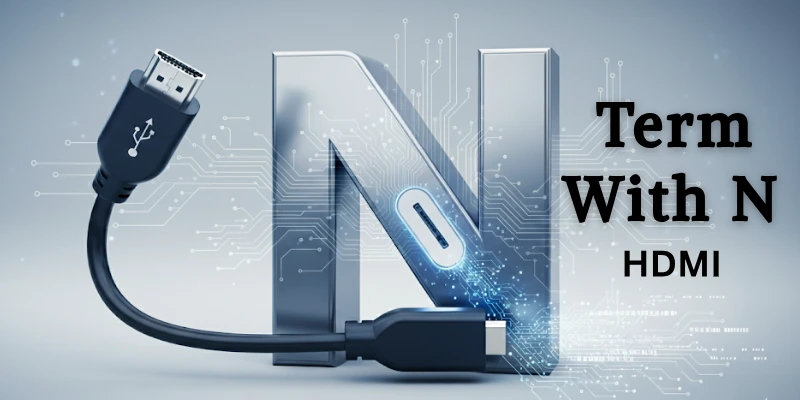
- Native Resolution – The highest resolution a display or TV can show without scaling.
- Noise Reduction – A feature in HDMI-connected devices that removes unwanted grain or distortion from video and audio.
- Non-Compressed Audio – HDMI’s ability to send pure, high-quality audio without any compression (e.g., PCM).
- Network Channel (HDMI Ethernet Channel – HEC) – A feature in some HDMI cables that allows devices to share an internet connection.
- Nominal Voltage – The standard voltage level at which HDMI devices operate safely.
- Nits (Brightness Measurement) – A unit that measures how bright an HDMI-connected screen can get.
- Non-Linear Editing (NLE) – A technique used in video production where HDMI-connected editing tools allow for flexible video editing.
- Noise Floor – The level of background noise in an HDMI audio signal.
- NTSC (National Television System Committee) – An older analog video standard replaced by digital HDMI signals.
- Non-HDCP Content – Video or audio that does not require HDCP (High-bandwidth Digital Content Protection) to play.
- Near Field Communication (NFC) with HDMI – Some modern HDMI devices use NFC for quick wireless pairing.
- Neutral Color Processing – A feature in HDMI displays that ensures accurate color representation without oversaturation.
- Networked AV (Audio/Video over HDMI) – HDMI’s ability to integrate with network-based AV systems for streaming.
- Non-Volatile Memory in HDMI Devices – Memory in HDMI devices that retains settings even when powered off.
- Noise Filtering in HDMI Cables – A feature in high-quality HDMI cables that reduces signal interference and distortion.
Terms with O
That’s your O HDMI key term list!
- Overscan – When an image extends beyond the edges of a screen, cutting off parts of the picture.
- Optical HDMI Cable – A fiber-optic HDMI cable that transmits signals over long distances with no loss of quality.
- Output Port – The HDMI port on a device that sends video and audio signals to a display.
- On-Screen Display (OSD) – Menu or settings shown on the screen, often accessed via HDMI devices.
- Optical Audio vs. HDMI Audio – Optical cables only carry audio, while HDMI carries both audio and video.
- Open Source HDMI Standards – Some HDMI features have open-source alternatives for developers and manufacturers.
- Overhead Audio (Dolby Atmos) – HDMI supports overhead sound channels for a 3D audio experience.
- OLED (Organic Light-Emitting Diode) – A display technology that provides deeper blacks and better contrast for HDMI-connected screens.
- One-Touch Play (CEC Feature) – A feature where turning on one HDMI device automatically turns on others connected via HDMI-CEC.
- Output Resolution – The resolution at which a device sends video signals through HDMI (e.g., 1080p, 4K).
- Overclocking HDMI Refresh Rate – Manually increasing the refresh rate of an HDMI-connected display for smoother motion.
- Offset (Color Calibration) – A setting that adjusts the black level of HDMI video signals to improve contrast.
- OCA (Optional Content Authentication) – A security feature that protects HDMI content from being altered or pirated.
- Optical Disc Players (Blu-ray, DVD) – Devices that use HDMI to output high-quality digital video and audio.
- Over-the-Air (OTA) Updates for HDMI Devices – Some HDMI devices receive firmware updates over the internet for better performance.
Terms with P
Here is your P list!
- Progressive Scan (1080p, 720p, etc.) – A video format where each frame is displayed fully, leading to smoother motion than interlaced video.
- Port (HDMI Port) – A physical connection on a device where an HDMI cable is plugged in.
- Pixel Clock – The speed at which pixels are transmitted over HDMI, affecting resolution and refresh rate.
- Pixel Depth (Color Depth) – The number of bits used to represent each color in an HDMI image (e.g., 8-bit, 10-bit, 12-bit).
- Packet-Based Transmission – HDMI sends data in small packets to support features like Ethernet and audio return.
- Plug-and-Play (PnP) – HDMI devices automatically detect and configure settings when connected, without manual setup.
- Picture-in-Picture (PiP) – A feature where a smaller video window appears inside the main HDMI display.
- Power Over HDMI (POH) – Some HDMI cables can transmit power to connected devices, reducing the need for separate power adapters.
- Premium High-Speed HDMI Cable – A certified HDMI cable that supports 4K at 60Hz with HDR and wide color gamut.
- Polarization (3D HDMI Display) – A method used in 3D TVs to separate images for each eye via HDMI.
- Primary Display – The main screen that receives video output from an HDMI source.
- Plasma Display – An older type of display technology that uses HDMI for high-definition video.
- Pass-Through (HDMI Audio & Video) – A feature where an HDMI signal is passed unchanged through a device like a receiver.
- Processor (HDMI Video Processor) – A chip that enhances video quality, scaling, and color processing for HDMI output.
- Playout (HDMI Video Playout System) – A system used in broadcasting that sends HDMI video signals to a display.
- Panel Bit Depth – The bit depth of a screen (e.g., 8-bit, 10-bit) that determines color accuracy via HDMI.
- Power Management via HDMI-CEC – HDMI devices can turn on/off together using CEC (Consumer Electronics Control).
- Protected Video Path (PVP) – A security feature that prevents unauthorized recording of HDMI content.
- Post-Processing (HDMI Image Enhancement) – Image improvements like noise reduction and sharpness applied after HDMI signal transmission.
- Port Saver Adapter – A small HDMI adapter that prevents wear and tear on HDMI ports.
- Projection (HDMI to Projector Connection) – Connecting a projector via HDMI for large-screen video display.
- Passive HDMI Cable – A standard HDMI cable without built-in signal boosters (for short distances).
- Programmable EDID – Advanced HDMI feature allowing devices to customize resolution and refresh rate detection.
Terms with Q
This is a detailed list of HDMI terms starting with “Q”.
- Quad HD (QHD) – A resolution of 2560×1440 pixels, supported by HDMI for sharper images than Full HD.
- Quad View (Multi-View HDMI Feature) – An HDMI feature that allows four video sources to be displayed simultaneously on one screen.
- Quantum Dot Display – A display technology that enhances color accuracy and brightness using HDMI input.
- Quality of Service (QoS) in HDMI Ethernet) – A feature that prioritizes HDMI network data to ensure smooth video streaming.
- Quick Frame Transport (QFT) – An HDMI feature that reduces display lag, improving gaming and virtual reality experiences.
- Quick Media Switching (QMS) – Prevents screen blackouts when switching between different HDMI video frame rates.
- Quad Buffering (3D HDMI Graphics Processing) – A technique used in 3D graphics to store multiple frames, reducing flickering.
- Quasi-Interlaced Display – A hybrid display method where HDMI mimics interlaced video using progressive scan.
- Quad HDMI Output – Devices with four HDMI output ports to connect multiple displays simultaneously.
- Quantization (HDMI Signal Processing) – The process of converting analog signals to digital values for HDMI transmission.
Terms with R
That’s your R HDMI list!
- Rainbow Effect – A visual artifact seen in some HDMI projectors using DLP technology, causing color streaks.
- Raw Bitstream Audio – Unprocessed audio transmitted via HDMI for decoding by an external device like an AV receiver.
- Receiver (AV Receiver) – A device that processes HDMI audio and video signals for home theater systems.
- Refresh Rate – The number of times a display updates per second, measured in Hz (e.g., 60Hz, 120Hz, 240Hz).
- Resolution – The number of pixels in a display, such as 1080p (Full HD), 4K, and 8K.
- Response Time – The time it takes a pixel to change from one color to another in an HDMI display.
- RGB (Red, Green, Blue) – A color format used in HDMI to represent video images.
- RGB Limited (16-235) – A compressed color range used in HDMI for standard video playback.
- RGB Full (0-255) – A full color range used in HDMI for PCs and gaming for better color accuracy.
- Rolling Shutter Effect – A distortion seen in fast-moving objects in HDMI video due to sensor scanning speed.
- Room Calibration (HDMI Audio Feature) – A process where HDMI-connected AV receivers adjust sound based on room acoustics.
- RS-232 over HDMI – A feature that allows HDMI to transmit control signals for home automation systems.
- Return Loss – A measure of signal reflection in HDMI cables that can affect video quality.
- Remote Control Passthrough (CEC Feature) – Allows a single remote to control multiple HDMI-connected devices.
- RCA to HDMI Converter – A device that converts older analog RCA signals to HDMI for modern displays.
- Raw Video Format – An uncompressed HDMI video signal that retains full image quality.
- Resolution Scaling – An HDMI feature that adjusts video resolution to fit the display’s native resolution.
- Re-clocking (HDMI Signal Correction) – A process that corrects timing errors in HDMI signals for better stability.
- Real-Time HDR Processing – An HDMI feature that dynamically adjusts HDR settings for improved video quality.
- Repeater (HDMI Repeater) – A device that amplifies HDMI signals for longer cable runs.
Terms with S
This is a detailed list of HDMI terms starting with “S”.
- Sampling Rate – The number of audio samples taken per second, affecting HDMI audio quality.
- Scaling – An HDMI feature that adjusts video resolution to fit the screen properly.
- Screen Tearing – A visual glitch where two frames appear on the screen at the same time due to unsynced HDMI signals.
- SD (Standard Definition) – A lower resolution video format (480p or lower) transmitted via HDMI.
- SDR (Standard Dynamic Range) – A video format with a limited color and brightness range compared to HDR.
- Seamless Switching – An HDMI feature that allows smooth transitions between input sources without delay.
- Self-Powered HDMI Cables – HDMI cables that don’t require external power and use built-in circuits.
- Serial Data Channel (SDC) – An HDMI component that helps with communication between connected devices.
- Shielded HDMI Cable – A cable with extra protection to reduce interference and signal loss.
- Short Range HDMI – A type of HDMI cable designed for short distances, usually under 2 meters.
- Signal Degradation – The weakening of an HDMI signal due to long cable lengths or poor cable quality.
- Signal Booster – A device that amplifies HDMI signals for long cable runs.
- Single-Link HDMI – An HDMI connection type with a lower bandwidth than dual-link.
- Sink Device – The receiving device in an HDMI connection, such as a TV or projector.
- Source Device – The sending device in an HDMI connection, like a Blu-ray player or gaming console.
- Spatial Audio – A 3D audio technology that improves sound positioning in HDMI-connected devices.
- SPDIF to HDMI Converter – A device that converts SPDIF digital audio to HDMI audio.
- Stereoscopic 3D – A feature that allows HDMI to transmit 3D video signals to compatible displays.
- Streaming Stick (HDMI Dongle) – A small device like Chromecast or Fire Stick that connects via HDMI for streaming.
- Subsampling (Chroma Subsampling) – A video compression technique in HDMI to reduce data size while keeping good quality.
- Surround Sound – An HDMI audio feature that provides multi-channel sound for an immersive experience.
- Switching Delay – The time taken by an HDMI device to switch between input sources.
- Sync Signal – A timing signal in HDMI that ensures smooth audio and video playback.
- System Audio Control (CEC Feature) – Allows HDMI devices to control audio volume across multiple connected devices.
Terms with T
Here is your T list!
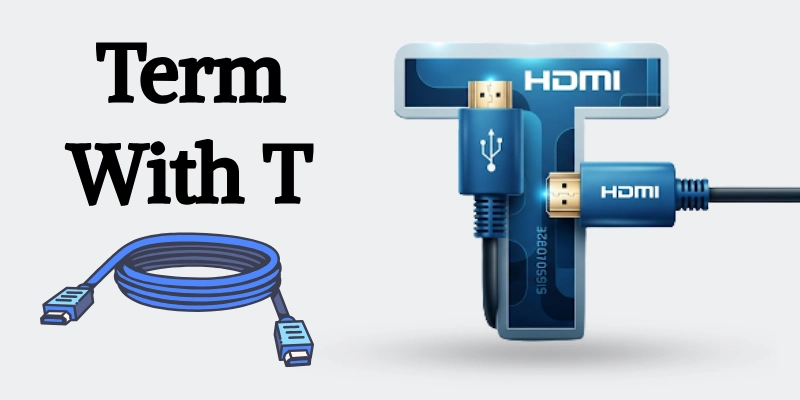
- Tearing (Screen Tearing) – A visual issue where multiple frames are shown at once due to unsynced HDMI signals.
- Temporal Dithering – A technique used in HDMI displays to simulate more colors than the panel can natively show.
- Termination (Cable Termination) – The process of properly ending an HDMI cable connection to avoid signal loss.
- Thin HDMI Cable – A slim and lightweight HDMI cable designed for portability and flexibility.
- Thunderbolt to HDMI Adapter – A device that converts a Thunderbolt signal to HDMI for display output.
- Timecode Over HDMI – A feature that allows accurate frame syncing for professional video production.
- Timing Signal – An HDMI signal that helps keep video and audio perfectly in sync.
- TMDS (Transition Minimized Differential Signaling) – A method HDMI uses to send data efficiently with minimal loss.
- TOSLINK to HDMI Converter – A device that converts optical audio (TOSLINK) to HDMI for better compatibility.
- Touchscreen Over HDMI – A feature in some HDMI devices that allows touch interaction when connected to a touchscreen monitor.
- Transmission Bandwidth – The amount of data an HDMI cable can handle per second, affecting video and audio quality.
- Triple-Layer Shielding – A protective layer in HDMI cables that reduces interference and enhances signal quality.
- True Color (24-bit, 30-bit, 36-bit) – An HDMI feature that supports millions to billions of colors for accurate display.
- TV Tuner Over HDMI – A feature allowing broadcast TV signals to pass through an HDMI connection.
- Type A HDMI Connector – The standard HDMI connector found on most devices like TVs and gaming consoles.
- Type B HDMI Connector – A rarely used HDMI connector with more pins, meant for high-resolution video.
- Type C HDMI (Mini HDMI) – A smaller HDMI connector used in tablets, cameras, and laptops.
- Type D HDMI (Micro HDMI) – An even smaller HDMI connector used in smartphones and action cameras.
- Type E HDMI Connector – An HDMI connector designed for automotive use in vehicles.
- Two-Way HDMI Splitter – A device that takes one HDMI signal and splits it into two outputs for multiple screens.
Terms with U
Here is the U list.
- Ultra High-Speed HDMI Cable – A cable designed to support HDMI 2.1 features, including 8K and 10K video.
- Ultra HD (UHD) – A high-resolution format (4K or higher) supported by HDMI for better picture quality.
- Ultra HD Deep Color – An HDMI feature that enables richer colors and better image depth.
- Uncompressed Audio – Audio signals sent through HDMI without quality loss, such as Dolby TrueHD and DTS-HD Master Audio.
- Uncompressed Video – A video signal sent through HDMI without compression, maintaining maximum quality.
- Underscan – An HDMI display setting that shrinks the image to ensure the entire picture fits on the screen.
- Upscaling – A feature that enhances lower-resolution content to look better on high-resolution HDMI displays.
- USB to HDMI Adapter – A device that converts a USB signal into HDMI for connecting external displays.
- USB-C to HDMI – An adapter or cable that allows USB-C devices to output video through HDMI.
- User-Selectable Refresh Rate – An HDMI feature that allows users to change the refresh rate for smoother visuals.
Terms with V
That’s the V list!
- Variable Refresh Rate (VRR) – An HDMI 2.1 feature that reduces screen tearing and lag in gaming.
- VGA to HDMI Converter – A device that converts analog VGA signals to digital HDMI for modern displays.
- Video Bandwidth – The amount of data an HDMI cable can transfer per second, affecting video quality.
- Video Codec – A system that compresses and decompresses video signals transmitted via HDMI.
- Video Compression – A technique used to reduce video file size without major quality loss in HDMI transmissions.
- Video Scaling – A process where HDMI devices adjust video resolution to match the display screen.
- Video Signal – The data transmitted through HDMI that carries video information from a source to a display.
- Viewing Angle – The maximum angle from which an HDMI display can be viewed without losing quality.
- VESA (Video Electronics Standards Association) – An organization that sets display standards, including HDMI compatibility.
- V-Sync (Vertical Sync) – A technology that prevents screen tearing by synchronizing HDMI display refresh rates with GPU output.
Terms with W
Here is the list of all the “W” key terms.
- Wall Mount HDMI Plate – A wall-mounted HDMI connector for a clean and organized cable setup.
- WCG (Wide Color Gamut) – An HDMI feature that displays a broader range of colors for better visuals.
- Whitelisting (HDCP Whitelisting) – A process where specific HDMI devices are approved to bypass HDCP protection.
- Wireless HDMI – A technology that transmits HDMI signals without cables, using Wi-Fi or RF.
- WLED (White LED Backlight) – A display backlight technology used in HDMI-compatible LED screens.
Terms with X
There aren’t many HDMI-related terms starting with X, but here are some key ones.
- X.V.Color (xvYCC) – An expanded color space supported by HDMI for richer and more accurate colors.
- Xbox HDMI Compatibility – Refers to HDMI support in Xbox consoles for high-quality gaming and media streaming.
- XGA (Extended Graphics Array) – A display resolution (1024×768 pixels) sometimes used with HDMI connections.
Terms with Y
Here are some HDMI-related terms starting with the letter ‘Y’:
- YCbCr: A color system used in video that separates brightness (Y) from color information (Cb and Cr).
- YPbPr: An analog version of YCbCr, used in older video equipment to transmit color signals.
- YUV: Another color system where ‘Y’ stands for brightness, and ‘U’ and ‘V’ carry color details.
- Y/C (S-Video): A video format that keeps brightness (Y) and color (C) signals separate to improve picture quality over older methods.
- xvYCC: An extended color space standard that allows for more vivid colors in video displays.
Terms with Z
Here are the Z terms in HDMI.

- Zero Latency Mode – A setting that reduces input lag for instant response, useful in gaming and video playback.
- Zoom Scaling – An HDMI feature that enlarges or shrinks video output to fit a screen properly.
- Zone Control (HDMI Receivers) – A feature in AV receivers that allows HDMI signals to be sent to different zones (rooms) independently.
Conclusion
In this article, we have covered every possible HDMI-related term from A to Z in simple and easy-to-understand words. As HDMI technology continues to evolve, new terms and features will emerge. If you think we missed any important HDMI terms or if you have questions, feel free to drop a comment below! We’d love to hear your thoughts and keep this glossary updated with the latest advancements.
Bookmark this page so you can always come back whenever you need to look up an HDMI term!
FAQs
Here are some of the most commonly asked questions related to the HDMI glossary:
The HDMI technology is a complicated one that has a lot of features. A different aspect of how HDMI operates is explained by each of these terms. Knowing these terms helps you choose the right cable and settings.
For those who are not skilled in technology, the most important term to know is the HDMI version. In other words, it reveals the capabilities of your HDMI port or cable. The most recent version, HDMI 2.1, is compatible with the most advanced features.
HDCP, which stands for High-bandwidth Digital Content Protection, prevents the copying of television shows and films. In the event that your HDMI device does not support HDCP, you may experience glitches or a black screen screen.
These are different sizes of HDMI ports:
- Type A – The standard HDMI port (TVs, laptops).
- Type B – Rarely used, designed for high-quality video.
- Type C – Mini HDMI (Cameras, tablets).
- Type D – Micro HDMI (Small devices like GoPro).
- Type E – Used in cars for automotive displays.
The HDMI cables that have been certified have been tested to ensure that they meet quality standards. These cables give better performance and fewer errors. It’s always good to buy a certified cable.
Bandwidth decides how much data your HDMI cable can carry. Better pictures, faster refresh rates, and support for 4K or 8K resolution are all benefits of having a higher bandwidth.

- Be Respectful
- Stay Relevant
- Stay Positive
- True Feedback
- Encourage Discussion
- Avoid Spamming
- No Fake News
- Don't Copy-Paste
- No Personal Attacks

- Be Respectful
- Stay Relevant
- Stay Positive
- True Feedback
- Encourage Discussion
- Avoid Spamming
- No Fake News
- Don't Copy-Paste
- No Personal Attacks



